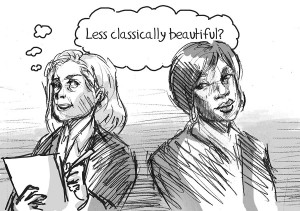NYT gaffe calls for beauty standards change
Sometimes, a racially related compliment can unintentionally serve as an insult. An article from The New York Times’ TV critic Alessandra Stanley has been the most recent example of this social phenomenon. In her Sept. 18 review of ABC’s newest show How to Get Away with Murder, Stanley called two-time Oscar nominee Viola Davis “less classically beautiful.” Though Stanley later defended her piece by saying that the main point of her piece was to praise director Shonda Rhimes for “pushing back so successfully on a tiresome but insidious stereotype,” her statement about Davis shows that there are still walls to overcome when discussing standards of beauty.
With the power to widely distribute images in TV and magazines, the media has long set a mold for the face of beauty. More often than not, African American women have not been considered beautiful, a notion rooted in the long history of racism in this country. Referring to Davis, Stanley wrote, “The actress doesn’t look at all like the typical star of a network drama. Ignoring the narrow beauty standards some African-American women are held to, Ms. Rhimes chose a performer who is older, darker-skinned and less classically beautiful than Ms. [Kerry] Washington.” Though she acknowledged that there are unfair beauty standards for women of color — and also a preferred look for African-American women — Stanley seems to be aligning with those same unreal standards.
Stanley could have praised Davis for being on a network show despite the actress starring in feature films. She could have praised Davis for being the lead of a show when there are so few women in that position. Instead, she chose to call the an acclaimed actress “less classifcally beautiful” than the lighter-skinned Washington, shifting the conversation to her race.
Another point of contention with the article is its name — “Wrought in Rhimes’s Image.” For one, the article incorrectly stated that the executive producer Shonda Rhimes, who is also a black woman, was the creator of the latest show that placed another African-American woman as its lead. The fact is that a white man, Peter Nowalk, created How to Get Away with Murder. Yet that was not the most upsetting part of Stanley’s assessment of how black women are portrayed in the media.
Stanley did not have to use harsh comparisons and misconstrued ideas to get across a point. Davis’s beauty and professional accomplishments should stand for themselves if we are truly comparing African-Americans with their white counterparts.
When TV critics evaluate shows, their assessments should be based on the viability of plot. It should not center on the racial makeup of the characters. That’s what makes shows similar to How to Get Away with Murder, such as Rhimes’s Scandal, so interesting. Viewers are drawn into the plotlines. A character’s race is just one of his or her many attributes.
Though the article, with its wild claims and opinions, might not be cause for Stanley’s termination, it does show that changes need to be made when discussing standards of beauty. The New York Times’ culture editor Danielle Mattoon wrote on Monday, “This is a signal to me that we have to constantly remind ourselves as editors of our blind spots, what we don’t know, and of how readers may react.”
The only way to make these necessary changes in the way we think of African-American women and what makes them beautiful is to talk about it.
Stanley’s assessment of the latest show from Rhimes’s production company reveals how much work still needs to be done when it comes to race relations in the United States. The mere fact that it sparked such widespread conversations, however, shows that dialogue and understanding are achievable, so that when TV watchers tune in, they can be in tune with beauty standards that should reflect our multicultural world.


